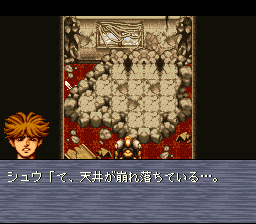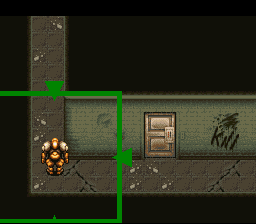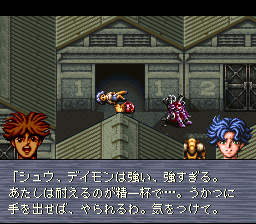Solid Runner (ソリッドランナー), released 3/28/1997, developed by Sting, published by ASCII

It was a strange experience starting up this game — it’s been sitting on my list for years as the final game I would play (at least once I started the SRPG project so that FE5 was no longer the last game). I didn’t know anything about it and have never heard anyone say anything about the game. But it’s probably a good final game in that it embodies a lot of the frustration that has arisen for me throughout the project. The game has a nice setting and the story has interesting aspects, but it’s hampered by a high random encounter rate and an interface that isn’t always friendly.

Of course as is true for most late-era SFC games, the graphics are good. The main character is Shuu Askin, who lives in Solid City. The game is taking place in 21XX in the real world; I think Solid City is supposed to be in Japan although the entire game is in the city so it’s not completely clear. Shuu uses a “runner” (basically a mech) to carry out various jobs for money. He’s engaged to Airin, the daughter of Tao who is the head of “Dark Dragon”, the town’s Chinese mafia. Recently they are having trouble with Babaria, a gang that has come in from Europe, who is selling drugs in the town.
The first part of the game is just taking some random jobs — a number of them involve “bio monsters” who are some kind of human-monster hybrid; this may be caused by the drugs or some other thing.

Shuu has a computer where he takes requests. You can also pay a small amount of money for rumors and information, but I was never clear on exactly what the purpose of that was. Maybe it unlocks some of the requests? (I think a few of them are optional). Once you have a request you have to go out to the town.

You can visit any place you know about (or at least is relevant) in the 10 sectors. At some point you will proceed to a dungeon area.

The random encounter rate is high. Every battle is 1 vs 1, which is pretty unusual for an RPG at this stage. You can use one of 4 weapons, which are generally two shoulder-mounted missile type things (which can reload at the cost of a turn), and then your right and left hand (which can be freely assigned but I usually had one melee and one shooting weapon). If you do a shooting weapon you can also hold left or right to strafe.
Both you and the enemy act at the same time. Depending on the moves chosen, one side might get an advantage — for instance, a strafe shot has the advantage over a melee attack. As far as I know there is no way to tell what the enemy is going to do except that enemies seem to have patterns that you can memorize (maybe even including bosses).
You can also “boost” which will increase your power for that round but runs the risk of breaking the weapon.

When you level up, you get stat bonuses and then you can go back to your base and pay the mechanic to raise the mech’s HP (and recover it to full). This is the only way to recover your mech’s HP aside from using items. Money is only gotten from completing requests (I think there are only 10 or so that actually give money) or selling drop items. Later on you can fight in a tournament that gives some extra money, but money is quite tight in general.
Buying things from the shop is frustrating because (in 1997!) the interface is still not very good in terms of showing you what kinds of items you are buying or how good they are compared to your current equipment.

The story is quite dark. Shuu used to be a soldier, but he quit after an incident he was involved in where civilians were killed by his troop. After a few missions, Babaria attacks Tao’s house, killing both him and Airin (Shuu’s fiancee). After that, Shuu’s goal is simply to take down Babaria.

Many of the requests are also quite dark stories, often ending with the deaths of people you were trying to save.
Around a third of the way through the game I lost one of my weapons to a boost, and I equipped an item I had found in a dungeon. This turned out to be very lucky because it was a melee weapon that inflicts the lightning bolt status on the enemy, which lowers their hit rate. This weapon made 90% of the remaining battles in the game trivial, including many of the bosses. The only enemies that presented any kind of challenge were ones that were immune to the status effect, and often I just ran from those fights.
I think the writer of the gamefaqs walkthrough was not aware of this because he recommends a ridiculous amount of grinding levels (especially near the end); I beat the game something like 30 levels below his recommendation.

The dungeons tend to be large and involve a lot of “throw switch to open door” or “find the keycard”. There were times when I turned on a no-encounter cheat because of how frustrating it was to figure out where to go when you are encountering monsters every few steps.

The storyline grows to involve Babaria’s research into bio creatures, and the attempts of some of the creatures to form their own way aside from humans. Babaria’s leader is I believe supposed to be a descendant of either Hitler or one of the high ranking Nazis.
Overall the story is not bad, and it’s unfortunate that it wasn’t paired with a somewhat better system — this is far from the worst I’ve played but there were so many ways that it could have been improved.

The end of the game at least is relatively happy, with Shuu finding a new love and continuing his work in Solid City.
—
So that is it — with game 128 I have (more or less) completed the project I set out to do when I started seven years ago nearly to the day (my first post was Feb 3, 2017 but I don’t know if that was the exact day I started playing GD Leen). It is very nice to have this off my plate.
I will do “final thoughts” post on the Super Famicom Games sometime in the middle of this week, and then starting next Saturday we’ll be back to 1998 SRPGs.